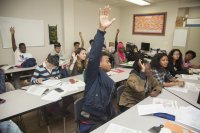Creating a Classroom Culture of Shared Ownership
Getting buy-in from students at the outset encourages them to engage more deeply in their learning.
We’ve all been there: In the middle of a class discussion, we realize that only a handful of kids are actually engaging in discourse with us and the rest are off-task. How can teachers ensure that all students take ownership of their learning?
Ask for Opinions
For students to be part of a classroom community, they need to have authentic buy-in from the beginning. Asking students what they think creates buy-in at the outset.
I begin my writing class by asking students to brainstorm the components of a good essay. In groups, they discuss what an ideal final product should include, sharing their ideas on chart paper or a Google Doc. We come back together and compare results. Not only is student engagement increased from having taken the time to develop ideas prior to a whole-class conversation, but also students are able to improve critical thinking and understand rubrics more comprehensively.
Allowing students to be part of the assessment creation gives them ownership in the entire process—not just the outcomes.
Emphasize Growth
Show students how they are becoming better learners on a regular basis, particularly by embracing mistakes. I frequently share my own errors so that students realize it’s OK to mess up as long as we learn from it. Last year, I told my class about a major mistake I made while I was leading a department meeting. At the time, I was relatively new to a data program, and when I pulled student performance numbers and downloaded them into a spreadsheet, I accidentally sorted a column incorrectly. The meeting was rough, but I learned from my mistake. Sharing this story helped my students understand why errors can be valuable.
Without the experiences of failure, we don’t get better. If we can make mistakes desirable, kids truly experience the value of a growth mindset that encourages a “not yet” approach to learning. Students are more likely to own their growth if they realize that success is a process that involves some struggle.
Gather Student Voices
I met with a team of teachers who were excited about students enjoying assigned reading. After listening to their theories about why students were more engaged, I asked if they could gather student data about this development. Once students shared that their increase in engagement was connected to more relatable reading options, teachers used actionable data to move forward. Rather than creating a series of hypotheses, ask kids what is happening from their perspective.
Responding to feedback and making changes based on their suggestions communicates to students that we value their ideas and perspectives. If students feel comfortable providing input that is informative but not tied to a grade or other consequence, we can better address learning needs.
Laugh With Students
Classrooms are hotbeds of unpredictability, and it is important to welcome spontaneity rather than shut it down. When a student made a presentation on the August Wilson play Fences and accidentally left the n out of the title, I did two things: I reinforced our culture of embracing mistakes, and I shared a time when I wrote an unfortunate typo, so that the laughter would be directed at the situation, not the student. If teachers welcome humor that is free of sarcasm, students will work that much harder to succeed. As a step toward creating student ownership, having a classroom full of laughter and humor builds relationships. When the teacher prioritizes strong rapport with students, kids are more likely to be vocal about their learning needs and take responsibility for their progress and achievement.
Redefine Class Participation
Not every student wants to speak up, while others may monopolize class discussions. Give students a variety of ways to express ideas. They can share thoughts with silent discourse—the process of writing a thoughtful comment or question and passing it to another student. They can put sticky notes on the board with their thoughts and place check marks next to ideas that have appeal. Whatever the method used to facilitate participation and student involvement in course content, vary it daily so that everyone has an opportunity to participate. When more students are involved in the class, their confidence increases, and they will drive their learning proactively rather than passively letting the teacher own the experience.
For nearly 20 years, I taught the same course, but I never taught it the same way from year to year. Even though I have discovered engaging reading strategies, I still experiment with new ways to provide divergent pathways to literacy. In the process, I discovered that students appreciate even a few minutes that are carved out to read a choice text. Responsive pedagogical practices take the end goal into account, enabling the teacher to vary practice. Suppose that students all have to demonstrate proficiency with a set of vocabulary words. Instead of providing one way for them to achieve the standard, such as writing a paragraph, let them own the experience by creating a graphic representation of the words or a podcast to demonstrate mastery of objectives. While changing it up is tricky, encouraging students to take risks pays off not only in content mastery, but also in encouraging student ownership of learning.
Providing choices, being flexible, and building positive relationships are the bedrock of making sure that kids know that they are the most important school stakeholders and that they own their learning.
